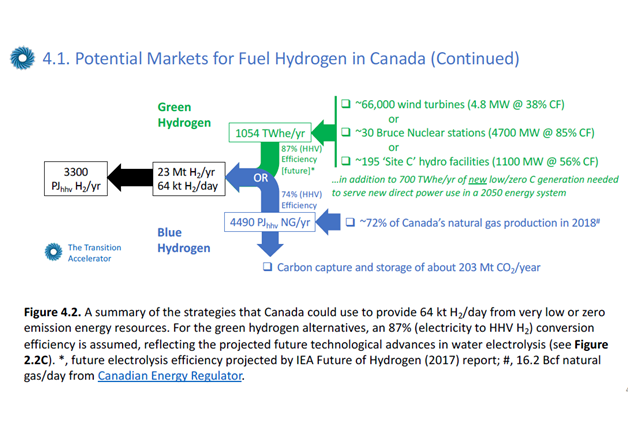@MLiebreich Technoeconomic environmental analysis is required to make these determinations, not just economic analysis. The overly electrical view is Euro-centric, does not build as a resilient enough system to replace hydrocarbons, doesn& #39;t reflect needs, resource capacity.. 2/
2/ ... & industrial capabilities of other world regions. And it does not address the credible, compelling, capable PATHWAYS needed to get to a clean 2050 energy future. Having a vision is great but you need a plan to get from here to there. Check this chart from page 45...3/
3/ ...of the Transition Accelerator Report Vol2 Issue 3 Sept 2020. The gist is that Canada is going to need to produce 64ktH2/d by 2050 for domestic consumption alone...8x what we make now. If we did that using Green hydrogen from windmills only...we would need 66,000 4.8MW... 4/
4/ ...wind turbines at 38%CF. From hydro electricity alone we would need 195 site C dams 1100MW at 56% CF. From nuclear alone, we would need 30 Bruce power nuclear stations 4700MW at 85% CF... OR if from Blue H2... would take 72% of Canada& #39;s natural gas production in 2018. 5/
5/ In some ways this makes your point for you that electricity is the way to go because Green H2 is so electricity intensive... however, it also makes the point that 2050 energy mix will be regional depending on resources and type of needs and uses. 6/
6/ H2 does so many things so much more easily and cost effectively than electricity ... as you said chem feedstocks and energy storage from curtailed renewables ... (small detour...my fav new tech for H2 from curtailed renewables is EVOLVE by http://www.gilmanindustries.com"> http://www.gilmanindustries.com w/no metal 7/
7/ ...electrodes. A game changer assuming it comes to fruition...now TRL 5-6). H2 is also better for heavy long distance transport, especially trucking, trains, & long distance buses. Catenary is just not feasible for the long distance trucking corridors we have in Canada. 8/
8/ Steel making requires the reductant capability of H2 to replace metallurgical coal. Other industrial heating needs H2 as electricity would be much too expensive to change over equipment and to pricey to use if you did... it is also less robust due to grid outages ...9/
9/ becoming more frequent with increases weather weirding, higher winds, ice storms etc. Same with home/building heating in cold climates where we either supplement heat pumps w/ H2 (good idea), or just use H2 depending on weather and re-purposing of existing infrastructure. 10/
10/ Shipping needs clean hydrogen for ammonia fuel combined with ammonia fuel cells to get around the ocean as quickly as they need to. (...not a fan of methanol). Long distance air transportation requires H2 as you know. 11/
11/ Bottom line is low C electricity AND low C hydrogen NEED each other to be economic, go easy on earth metals as each requires different ones, & add a similar robustness and resilience to the worldwide low C energy system we currently enjoy from hydrocarbons. 12/
Techno-economic environmental analysis is required to make these determinations, not just economic analysis. It is a mistake to make investments on economic analyses alone. You have power & Part II has already swayed investment in a wrong headed direction....problematic. end/

 Read on Twitter
Read on Twitter


